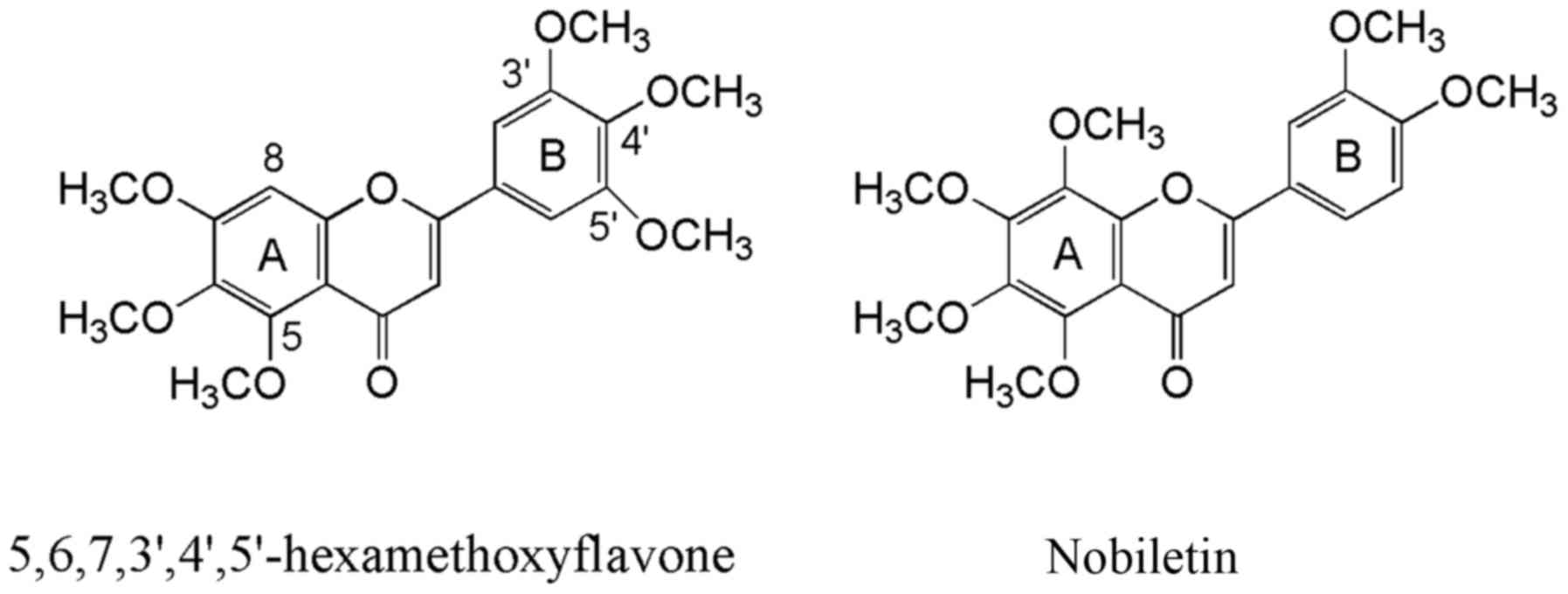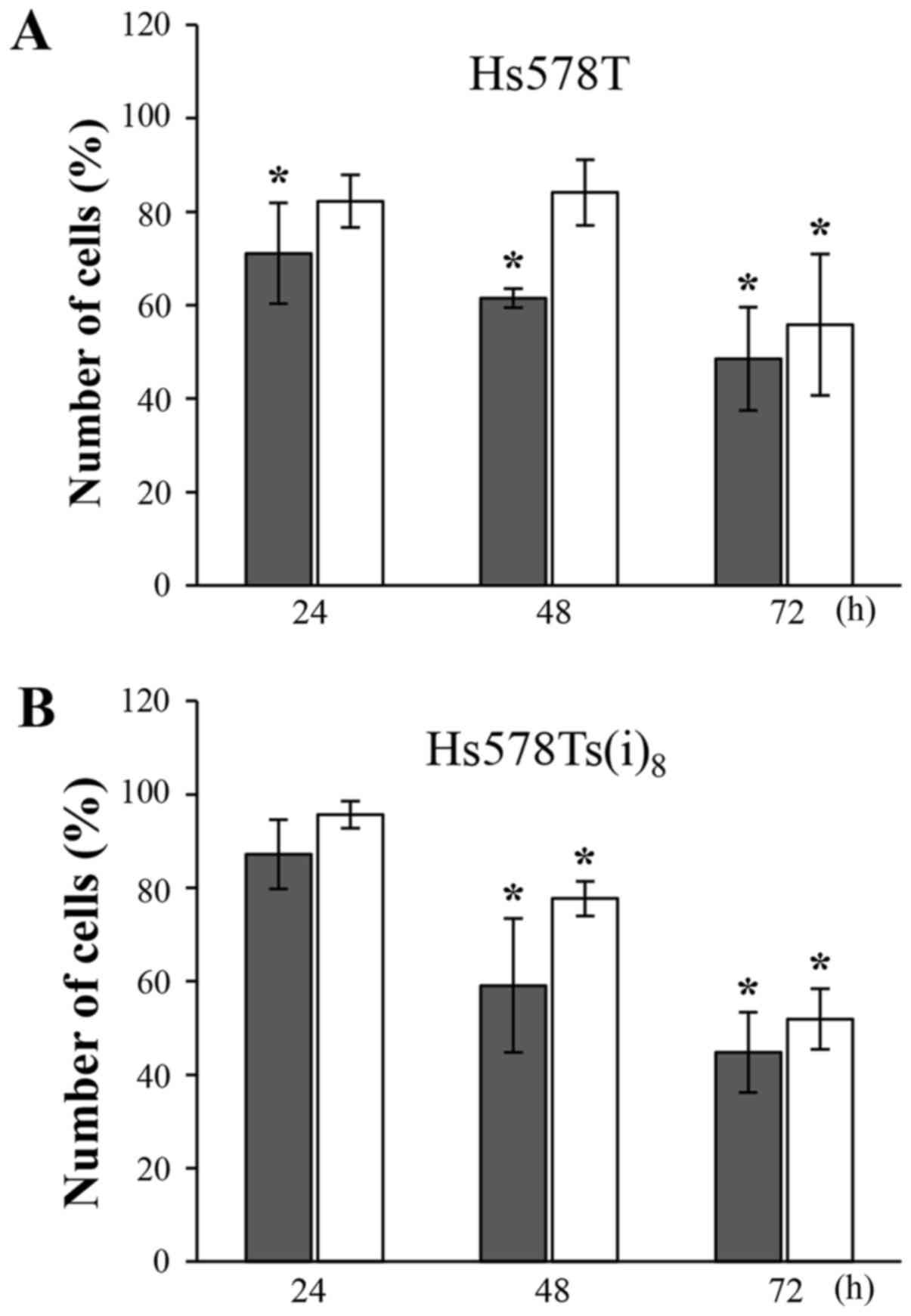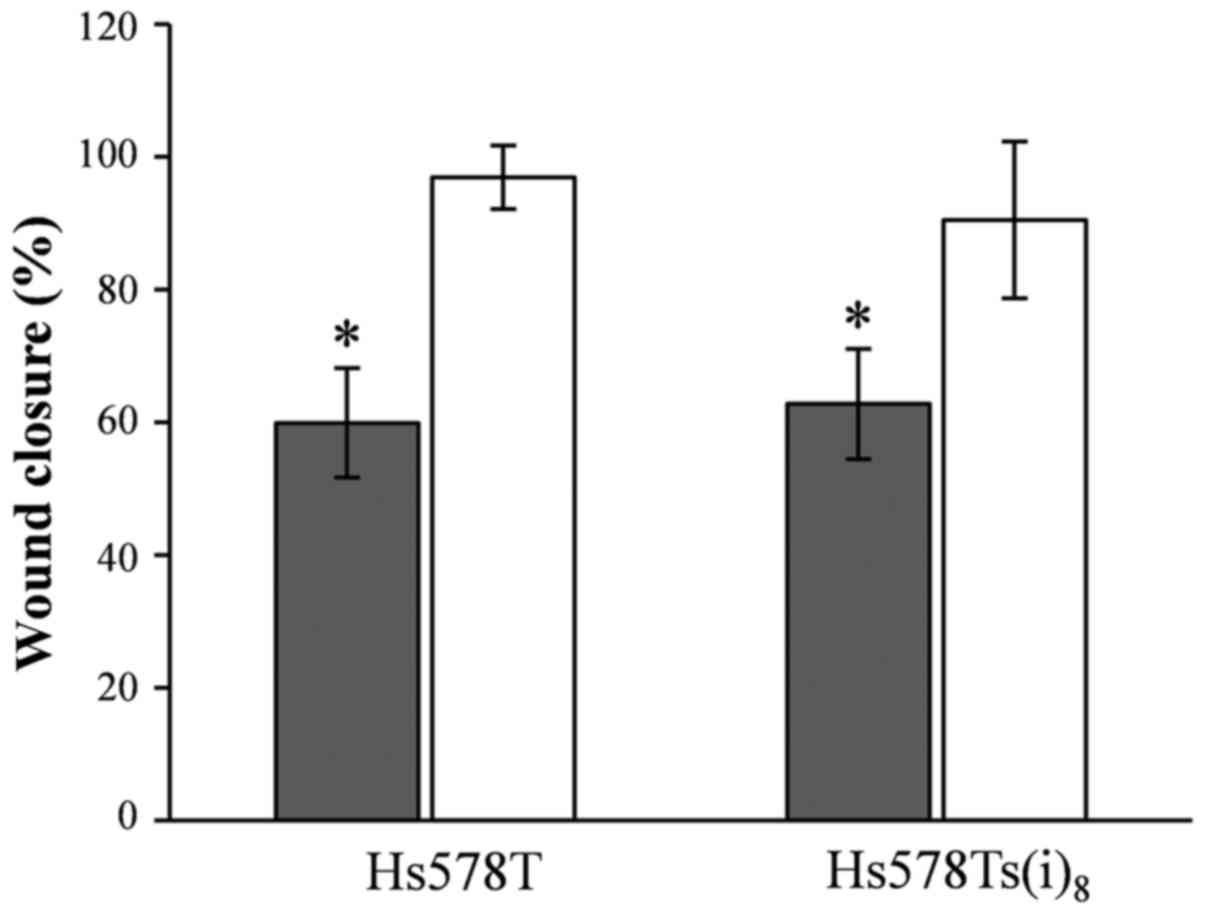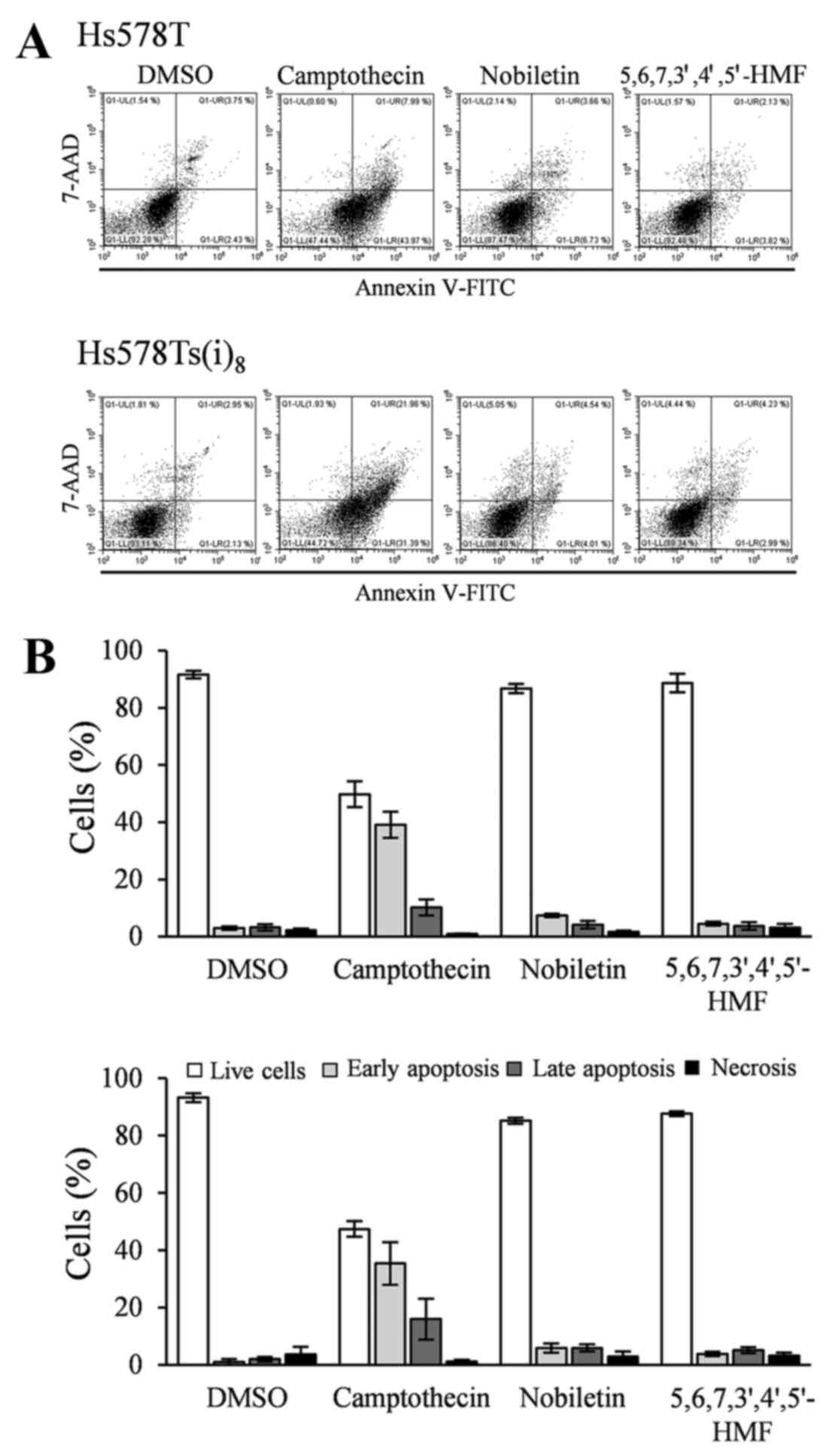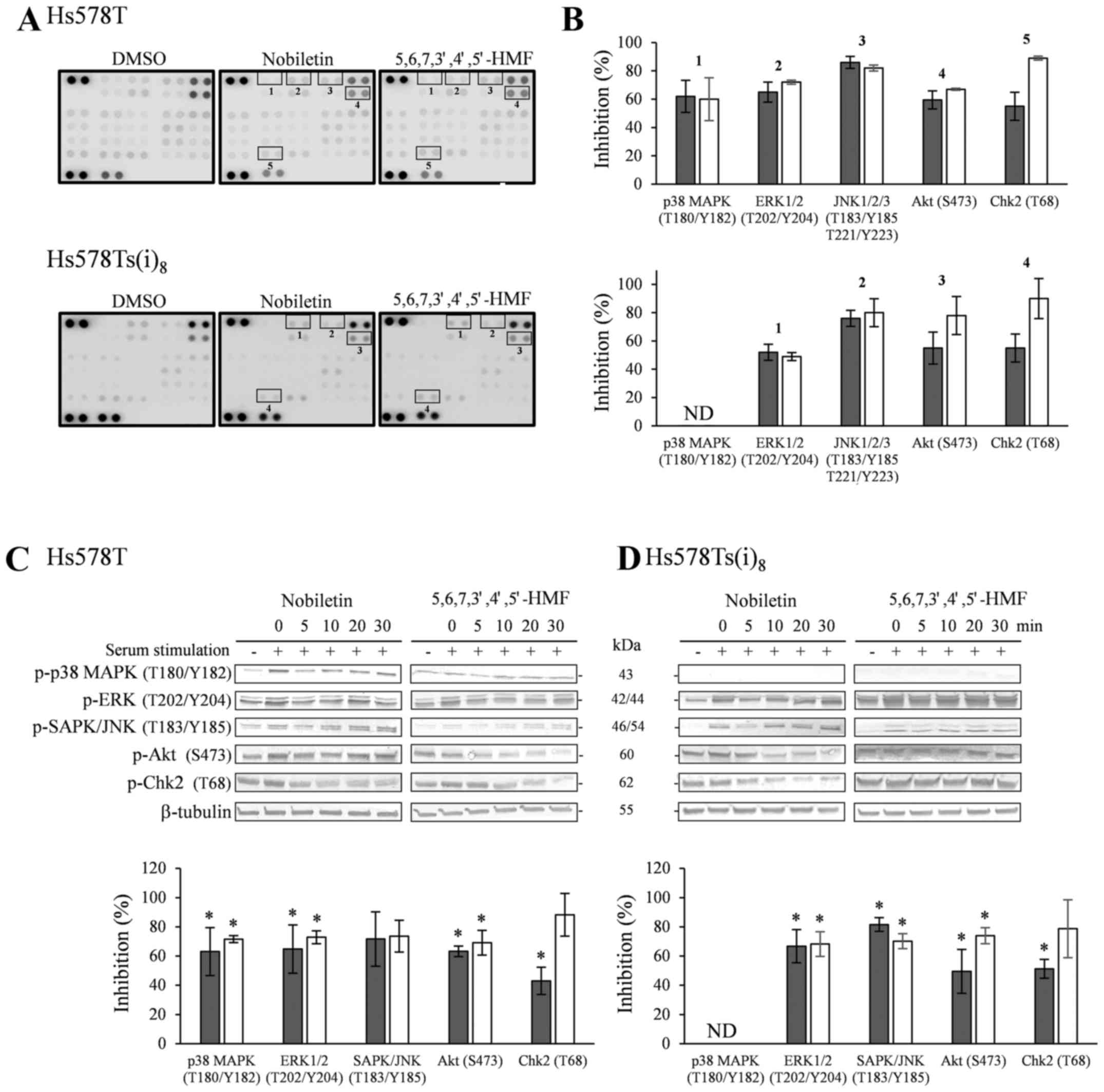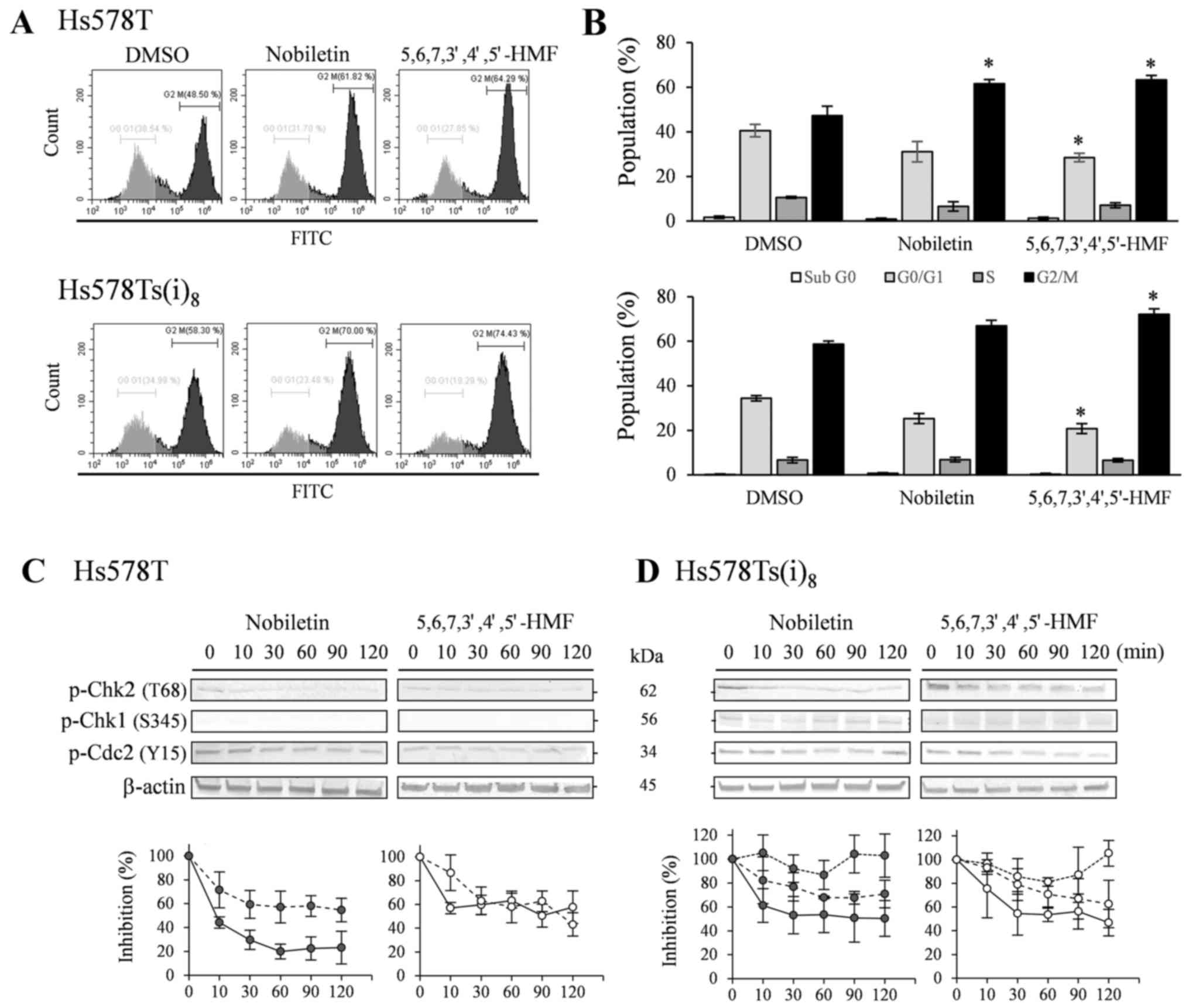5,6,7,3',4',5'-Hexamethoxyflavone inhibits growth of triple-negative breast cancer cells via suppression of MAPK and Akt signaling pathways and arresting cell cycle
- Authors:
- Published online on: October 13, 2017 https://doi.org/10.3892/ijo.2017.4157
- Pages: 1685-1693
-
Copyright: © Borah et al. This is an open access article distributed under the terms of Creative Commons Attribution License.
Abstract
Introduction
Compounds derived from natural products play an important role in the discovery of clinically suitable therapeutic agents. This is particularly true for anticancer medicines, with almost 70% of the novel anticancer drugs approved, over the past six decades, coming from natural products or based on the knowledge gained from natural products (1).
Recently, a renewed interest for flavonoids as anticancer agents has been catalyzed by flavopiridol (Alvocidib), a potent cyclin-dependent kinase (CDK) inhibitor, which has been granted orphan drug designation by the FDA in 2014 to treat patients with acute myeloid leukemia (2). Flavonoids are found throughout the plant kingdom and several epidemiological studies suggest that dietary intake of flavonoids is responsible for chemoprevention (3). Of particular interest are the polymethoxyflavones (PMFs), flavones substituted with two or more methoxy groups. This subclass of flavonoids is thought to be superior to polyhydroxylated flavonoids due to their increased metabolic stability, oral bioavailability and consequently improved cancer chemopreventive activities (4).
PMFs can be found in high concentrations in the peel of several Citrus species and in medicinal plants used in traditional medicine (5–7). Studies on the anticancer activity of PMFs have mostly been focused on nobiletin. This 5,6,7,8,3′,4′-hexamethoxyflavone has been shown to be effective in vitro and in vivo by affecting several cellular activities, including inhibition of cell proliferation, invasion and migration, inducing cell cycle arrest as well as reducing angiogenesis, signaling pathways and bioactivation by CYP1 (8–11). Notable also, is its predominant anticancer activity in MDA-MB-468 cells which indicates a potential role of nobiletin for the prevention of triple-negative breast cancer (TNBC) (12), an aggressive and highly metastatic subtype with poor prognosis for which hormonal therapy is not beneficial and chemotherapy remains the only treatment (13).
Studies with different Citrus species and medicinal plants indicate a high structural variability in PMF content, including the presence of smaller methoxyflavones and structural isomers. While several reports suggest that the anticancer activity from flavonoids is profoundly affected by their composition and structure, limited studies are published on the effect of these less known congeners (4), such as 5,6,7,3′,4′,5′-hexamethoxyflavone. This flavone has the same structural formula as nobiletin and has been isolated from Citrus reticulate and Ageratum conyzoides (Fig. 1). The compound was found to be cytotoxic against P-388 mouse leukemia cells, but not against the HT-29 human colon adenocarcinoma cell line and to suppress the degranulation from antigen-stimulated rat basophil RBL-2H3 cells through its effect on signaling as Syk/PLCγ's/PKC and mitogen-activated protein kinase (MAPK) pathways and Ca2+ influx (14,15).
The present study aimed at investigating the possible anticancer effects of 5,6,7,3′,4′,5′-hexamethoxyflavone and comparison against the well-studied nobiletin in the Hs578T progression model of TNBC. This in vitro cell system comprises the Hs578T TNBC cell line and its more metastatic and isogenic variant Hs578Ts(i)8 and embodies an elegant experimental model for studying the anticancer activity of both hexamethoxyflavones in TNBC and on TNBC progression (16).
Materials and methods
Antibodies and other reagents
Antibodies directed against p-ERK (D13.14.4E), p-JNK/SAPK (81E11), p-Akt (D9E), p-p38 MAPK (D3F9), p-Chk2 (C13C1), p-Chk1 (133D3), p-Cdc2 (10A11) and anti-β-actin (D6A8) or β-tubulin (9F3) antibodies as well as camptothecin were from Cell Signaling Technology (Danvers, MA, USA). Anti-mouse and anti-rabbit alkaline phosphatase-labeled secondary antibodies, the BCA protein assay reagent kit and trypan blue solution were from Thermo Fisher Scientific (Waltham, MA, USA). Drug toxicity was evaluated through measurement of mitochondrial dehydrogenase activities with 3-(4,5-dimethylthiazol-2-yl)-2,5-diphenyltetrazolium bromide (MTT) reagent (Sigma-Aldrich, St. Louis, MO, USA). Nobiletin and 5,6,7,3′,4′,5′-hexamethoxyflavone were obtained from Alkemist Labs (Costa Mesa, CA, USA).
Cell culture
The human mesenchymal breast cancer Hs578T cells and the derivative cell line Hs578Ts(i)8 were a kind gift from Dr S. McDonnell (UCD School of Chemical and Bioprocess Engineering, University College Dublin, Ireland) (16) and were grown in Dulbecco's modified Eagle's medium (DMEM) supplemented with 10% (v/v) fetal bovine serum (FBS), 100 IU/ml penicillin, 100 µg/ml streptomycin and 0.01 mg/ml bovine insulin (Thermo Fisher Scientific) at 37°C equilibrated with 5% (v/v) CO2 in humidified air. The TNBC cells used in the present study were frozen in liquid nitrogen when not in use and were not passaged in our laboratory for >15 weeks.
Assay for cell viability
The effect of nobiletin and 5,6,7,3′,4′,5′-hexamethoxyflavone on cell viability was tested in accordance with Romijn et al (17). Briefly, mitochondrial dehydrogenase activities were measured by an MTT reagent. Cells were seeded in 96-well plates at an initial density of 1.5×104 cells in 100 µl culture medium. After overnight incubation, cells were treated with nobiletin and 5,6,7,3′,4′,5′-hexamethoxy-flavone at a final concentration of 100, 50 and 10 µM. After 24 and 72 h of incubation, 100 µl medium was removed prior to the addition of MTT reagent, and formed formazan crystals were dissolved in 200 µl dimethyl sulfoxide (DMSO). Four independent experiments were completed to determine the mean absorbance referring to cell viability, using a Cytation™ 3 Cell Imaging Multi-mode reader with Gen5 software (BioTek Instruments, Inc., Winooski, VT, USA) and were expressed in percentage as compared to DMSO-treated control cells. In each experiment, eight wells were used per condition.
Cell counting
Cells were seeded in 25-cm2 culture flasks at an initial density of ~1.5×105 cells in 5 ml culture medium and were treated with nobiletin and 5,6,7,3′,4′,5′-hexamethoxyflavone at a final concentration of 100 µM after overnight incubation. The cells were allowed to grow for 24, 48 and 72 h, harvested using trypsin/EDTA and counted with a TC20™ automated cell counter (Bio-Rad Laboratories, Hercules, CA, USA). At least three independent experiments were performed to determine the mean value, which is presented as a percentage compared to the DMSO-treated controls.
Wound healing assay
Cells were grown in 24-well plates until confluency and washed twice with phosphate-buffered saline (PBS). A scratch was made using a P200 pipette tip and 1 ml of medium in the presence of DMSO, nobiletin or 5,6,7,3′,4′,5′-hexamethoxyflavone at 100 µM, was added. Cell migration was monitored and images were collected after 17 h, with an EVOS® XL Core Cell Imaging (Thermo Fisher Scientific). ImageJ software was used to estimate the cell free area of the wounds (18). The distances over which the cells migrated were measured in three independent experiments and expressed as percentage compared to DMSO-treated Hs578T and Hs578Ts(i)8 cells.
Proteome Profiler Human Phospho-kinase Array
Cells at 70% confluency were washed three times, serum-starved overnight, washed again and stimulated for 2 h with complete culture medium, followed by a treatment of 10 min with 100 µM nobiletin and 5,6,7,3′,4′,5′-hexamethoxyflavone prior to cell lysis. Lysates were made using kit components and the array experiments were performed following the manufacturer's instructions (R&D Systems, Inc., Minneapolis, MN, USA). Briefly, aliquots of cell lysates, containing 250 µg of protein, were incubated overnight with a human phospho-kinase array membrane containing capture antibodies against 43 different kinase phosphorylation sites. After washing, the membranes were incubated with biotinylated antibodies, streptavidin-HRP and chemiluminescent reagent for detection of phosphorylated protein at each capture spot on the membranes. Images were taken with a LI-COR® Odyssey Fc and analyzed with Image Studio 5.0 (LI-COR Biosciences, Lincoln, NE, USA) for determination of mean pixel density and further analyzed using Excel.
Western blotting
Confluent cell cultures (70%) were washed three times and for MAPK and Akt signaling experiments serum-starved overnight, washed again and stimulated for 2 h with complete culture medium prior to treatment with 100 µM nobiletin and 5,6,7,3′,4′,5′-hexamethoxyflavone for indicated times. For investigation of cell cycle regulators, 70% confluent cultures were not stimulated and washed three times. Subsequently, cells were lysed using lysis buffer containing 1% Triton X-100 and 1% Halt™ Protease Inhibitor Cocktail (Thermo Fisher Scientific). Aliquots of lysates containing 25–30 µg of proteins were boiled for 5 min in SDS-PAGE sample buffer supplemented with 5% β-mercaptoethanol, electrophoresed on 10% or 4–15% gradient Mini-PROTEAN® TGX™ gels and transferred to PVDF membranes (Bio-Rad Laboratories). After transfer, membranes were incubated with relevant antibodies against p-ERK, p-JNK/SAPK, p-p38 MAPK, p-Akt, p-Chk2 and Chk1, p-Cdc2 and β-tubulin or β-actin, as loading controls, followed by incubation with a secondary alkaline-phosphatase anti-rabbit antibody and stained with NBT/BCIP (1:50 in 0.1 M Tris-HCl, 0.05 M MgCl2 and 0.1 M NaCl at pH 9.5).
Flow cytometric analysis
Cells were treated for 72 h with 100 µM nobiletin and 5,6,7,3′,4′,5′-hexamethoxyflavone. Floating cells and trypsinized adherent cells were combined and washed with cold PBS or cell culture medium. For detection of apoptosis, cells were stained with an Annexin V/7-AAD kit (Beckman Coulter, Miami, FL, USA) using the manufacturer's protocol. In brief, cells were incubated with Annexin V and 7-AAD in ice-cold binding buffer in the dark. After 15 min the samples were mixed with more binding buffer and analyzed within 30 min. Positive controls for apoptosis induction included Hs578T and Hs578Ts(i)8 cells treated with 10 µM camptothecin for 72 h. Cell cycle analysis was investigated by adding Vybrant® DyeCycle™ Green Stain (Thermo Fisher Scientific) to 1 ml cell suspension at a final concentration of 250 nM. After 30-min incubation at 37°C, the samples were analyzed by flow cytometry and compared against DMSO-treated cells. All these experiments were performed on a CytoFLEX flow cytometer (Beckman Coulter) using CytExpert 2.0 software.
Statistics
All treatments were matched and carried out at least 3 times. Data were analyzed using Excel, for determination of mean, standard deviation (SD) and Student's t-test (95%). The intensity of the immunoblotted bands was quantified by densitometry, using statistical software Scion Image (Scion Corp., Frederick, MD, USA).
Results
Effect of nobiletin and 5,6,7,3′,4′,5′-hexamethoxyflavone on cell viability
Hs578T and the more invasive Hs578Ts(i)8 cells were treated for 24 and 72 h with nobiletin and 5,6,7,3′,4′,5′-hexamethoxyflavone at concentrations of 10, 50 and 100 µM and cytotoxicity was determined by the MTT-test. The effects of these compounds on cell viability are shown in Table I. Overall, the compounds did not have a major toxic effect toward the cell viability of the tested cell lines at 100 µM, after 24 and 72 h and consequently no IC50 values could be determined. Instead, nobiletin generally reduced the cell viability of the Hs578T and Hs578Ts(i)8 cell lines with ~30% after 24 h and 30–50% after 72 h at its highest concentration, while no noteworthy effect was observed for 5,6,7,3′,4′,5′-hexamethoxyflavone after 24 h (upper panel), and a small drop after 72 h (lower panel). Notably, we found that both nobiletin and 5,6,7,3′,4′,5′-hexame-thoxyflavone at 100 µM showed a greater toxicity toward the more invasive Hs578Ts(i)8 variant cell line, decreasing the cell viability to 51.6 and 68.1%, respectively, after 72 h.
Table IPercentage of cell viability of Hs578T and Hs578Ts(i)8 after 24 and 72 h nobiletin and 5,6,7,3′,4′,5′-hexamethoxyflavone treatment. |
Nobiletin and 5,6,7,3′,4′,5′-hexamethoxyflavone inhibit cell growth
The growth inhibitory effects of the compounds at 100 µM were evaluated after 24, 48 and 72 h by cell counting. Nobiletin and 5,6,7,3′,4′,5′-hexamethoxyflavone markedly inhibited the growth of Hs578T (Fig. 2A) and Hs578Ts(i)8 cells (Fig. 2B) in a time-dependent manner. After 24 h, limited effects were observed. After 48 and 72 h, however, nobiletin significantly reduced the amount of cells by roughly 40 and 50%, respectively. The growth inhibition following 5,6,7,3′,4′,5′-hexamethoxyflavone treatment was most pronounced after 72 h, and reached a level (~50%) almost similar to nobiletin. It should be noted, that the reduction in number of cells grown in the presence of nobiletin is relatively comparable to the data obtained in the MTT-assays (Table I), which may suggest a confounding effect due to its effect on cell viability.
Nobiletin and cell migration
In our previous study, we published that the Hs578Ts(i)8 cells migrate twice as fast compared to the parental Hs578T cells in a wound healing assay under normal growth conditions (19), which was in line with the earlier published increased migratory capacity of the more invasive Hs578Ts(i)8 cell line using the BD Matrigel™Invasion Chamber assay system (16). Herein, we tested the potential of nobiletin and 5,6,7,3′,4′,5′-hexamethoxyflavone to inhibit the migratory behavior, and this particularly of the Hs578Ts(i)8 cells. Results shown in Fig. 3 reveal that nobiletin at a concentration of 100 µM significantly reduced the migration by 40%, and that there was no selectivity toward the more migratory and invasive Hs578Ts(i)8 cells. In contrast, no effect was seen for 5,6,7,3′,4′,5′-hexamethoxyflavone and the wound was closed after 17 h, similar to the DMSO-control conditions. Yet again, the effect of nobiletin should be viewed with caution, as the growth inhibitory activity may confound the effect of nobiletin on cellular migration.
Effect of nobiletin and 5,6,7,3′,4′,5′-hexamethoxyflavone on apoptosis
Annexin V-FITC/7-AAD double staining was used to examine the effect of the two hexamethoxyflavones on the induction of cellular apoptosis. There are several compounds available to induce apoptosis in cancer cells in studies, in vitro. In vivo, taxanes have been shown to be beneficial in neoadjuvant, adjuvant, and metastatic settings in TNBC (20), and this specifically toward the basal-like (BL) 1 and 2 TNBC subtypes as compared to the mesenchymal-like and luminal androgen receptor subtypes (21). Since the Hs578T/Hs578Ts(i)8 breast cancer model represents mesenchymal-like TNBC, the well-known and universally used inducer of apoptosis, camptothecin, was used. While the addition of camptothecin in a final concentration of 5–10 µM and incubation in a time range of 4–24 h usually allows the evaluation of apoptosis in many cell lines, Hs578T and Hs58Ts(i)8 cells did not respond to the treatment within that time frame or after 48 h (data not shown). Instead, camptothecin-induced apoptosis was observed after 72 h at a concentration of 10 µM. Consequently, Hs578T and Hs578Ts(i)8 cells were exposed to nobiletin and 5,6,7,3′,4′,5′-hexamethoxyflavone for 72 h, and floating cells and adherent cells were combined prior to staining. Fig. 4A and the quantification in Fig. 4B indicate no significant differences in the Annexin V-FITC positive and 7-AAD positive or negative cells after 72-h treatment with nobiletin and 5,6,7,3′,4′,5′-hexamethoxyflavone at a final concentration of 100 µM as compared to DMSO and this in both cell lines. These results suggest that Hs578T and Hs578Ts(i)8 cells: i) are quite resistant toward camptothecin-induced apoptosis; and ii) do not undergo apoptosis after exposure to nobiletin and 5,6,7,3′,4′,5′-hexamethoxyflavone (Fig. 4).
Nobiletin and 5,6,7,3′,4′,5′-hexamethoxyflavone inhibit activation of distinct signaling molecules
With increasing knowledge on and complexity of signaling pathways as well as the fact that these pathways are highly cell-type specific, phospho-kinase arrays were performed alongside western blotting, to take an unbiased approach for analysis of affected signaling molecules and pathways upon treatment with the two hexamethoxyflavones. This was particularly important, given the uniqueness of the cell model system and the limited information available. Initially, western blotting was performed to determine an approximate optimal time-point in the cell lines used, for nobiletin and 5,6,7,3′,4′,5′-hexamethoxyflavone-mediated inhibition of phosphorylated ERK and Akt. The phosphorylation of these two signaling molecules is often found to be elevated after hormone or growth factor stimulation and inhibited following exposure to PMFs, such as nobiletin and tangeretin (8,22). Limiting factors to use this approach include the fact that these cell lines are triple-negative and the poor comprehension of the importance of growth factors in the behavior of the Hs578T and more migratory and invasive Hs578Ts(i)8 cells. The MAPK and Akt pathways are known to be activated by a variety of factors, among them receptor tyrosine kinases, integrin, cytokine and G-protein coupled receptors. Therefore, the method of overnight serum-starvation and serum stimulation was applied to achieve phosphorylation and demonstrate inhibition by nobiletin and 5,6,7,3′,4′,5′-hexamethoxyflavone. Responsiveness to serum stimulation, after overnight serum-starvation, with complete culture media was tested over time and 2 h proved to be an optimal stimulus, while a significant inhibition of the two hexamethoxyflavones could be observed as early as ~5–10 min after 100 µM treatment, with 10 min used in the subsequent array experiments.
The phospho-kinase array revealed a considerable amount of information, with most notably the decrease of p-ERK phosphorylation by nobiletin and 5,6,7,3′,4′,5′-hexamethoxyflavone as compared to DMSO-treated cells. A similar trend was observed for p-JNK1/2/3, although the effect was less pronounced. Moreover, both hexamethoxyflavones inhibited the phosphorylation levels of Akt, while the phosphorylation of checkpoint kinase 2 (Chk2) seemed to be solely reduced upon 10 min of nobiletin treatment. Additionally, phosphorylated p38 MAPK was only detected in the Hs578T cell line, and was inhibited by the two hexamethoxyflavones (HMFs) (Fig. 5A and B), while it was below the detection limit of the array for the Hs578Ts(i)8 cells. It must be mentioned that only two arrays per cell line and per component were performed to obtain initial data. Even though these arrays would allow for the quantification of the relative phosphorylation levels, the obtained results were further confirmed by western blotting in kinetics experiments in Hs578T (Fig. 5C) and Hs578Ts(i)8 (Fig. 5D) cells. Serum stimulation induced the phosphorylation of all kinases as compared to unstimulated cells, except for Chk2. Chk2 was not only found highly phosphorylated in these cell lines after serum-starvation but also under normal growth conditions (data not shown). Nobiletin and 5,6,7,3′,4′,5′-hexamethoxyflavone were able to inhibit the serum-induced phosphorylation of ERK, SAPK/JNK and Akt in a time range of 5–20 min in Hs578T and Hs578Ts(i)8 cells. Additionally, significant Chk2 phosphorylation inhibition was evident for nobiletin after 5 min, whereas 5,6,7,3′,4′,5′-hexamethoxyflavone significantly reduced the phosphorylation levels after treatments of 20 min and longer. Also in the western blotting experiments, phosphorylated p38 MAPK could only be clearly detected in the Hs578T cells under the experimental conditions used, and was reduced by nobiletin and 5,6,7,3′,4′,5′-hexamethoxyflavone over the investigated time range (Fig. 5C and D).
Nobiletin and 5,6,7,3′,4′,5′-hexamethoxyflavone affect the cell cycle
As a result of the significant nobiletin- and 5,6,7,3′,4′,5′-hexamethoxyflavone-mediated inhibition of Chk2 phosphorylation in the previous phosphokinase arrays and western blot experiments, the effect of both hexamethoxyflavones on the cell cycle was evaluated by performing a Vybrant® DyeCycle™ green staining. Comparison with DMSO-treated cells indicated that both hexamethoxyflavones upon treatment with 100 µM for 72 h, but not 48 h (data not shown), were able to cause a slight increase in G2/M arrest (Fig. 6A and B). While 5,6,7,3′,4′,5′-hexamethoxyflavone elevated the subpopulation of Hs578T and Hs578Ts(i)8 cells by 16.1 and 13.4%, respectively, nobiletin only significantly enhanced the G2/M arrest in Hs578T cells by 14.3%. Western blot results in Fig. 6C and D revealed that Chk2 phosphorylation at T68 decreased after 10 min in the presence of nobiletin (P<0.05) and 30 min with 5,6,7,3′,4′,5′-hexamethoxyflavone (P<0.05), without prior serum-starvation and stimulation, in both cell lines. Additionally, Chk1 phosphorylation levels were below or near the detection limit in the Hs578T cell lines, whereas weak levels were detected in the more invasive variant, which were not notably altered in the presence of the HMFs. Furthermore, phosphorylation levels of the cell division cycle 2 (Cdc2), known as CDK1, which acts downstream from Chk1 and regulates G2/M arrests, were found significantly decreased after 30-min exposure to nobiletin and 5,6,7,3′,4′,5′-hexamethoxyflavone in the Hs578T and after 30 to 60 min in Hs578Ts(i)8 cells (P<0.05).
Discussion
The present study reports for the first time on the anticancer activity of 5,6,7,3′,4′,5′-hexamethoxyflavone. This polymethoxyflavone is a structural isomer of 5,6,7,8,3′,4′-hexamethoxyflavone, known as nobiletin. They differ in the position of one methoxy group either on ring A or B (Fig. 1). While nobiletin is widely studied and known for its beneficial effects on cancer cells, 5,6,7,3′,4′,5′-hexamethoxyflavone is not, despite being isolated from the same sources and the recognized concept of isomerism affecting biological activity (4,13,15,23).
In the present study, we used the Hs578T/Hs578Ts(i)8 breast cancer progression model (16,19) for several reasons, including the potential role of nobiletin against TNBC (12) and in prevention of metastasis (8–10). Our results indicated that 5,6,7,3′,4′,5′-hexamethoxyflavone is less toxic than nobiletin against Hs578T and Hs578Ts(i)8 cells, while exerting a nearly similar effect as nobiletin in the cell counting experiments after 72-h treatments. Additionally, only nobiletin reduced the migratory behavior with almost 40% within 17 h in both cell lines. The effects of nobiletin on cell viability are in the same range as previously published studies using MCF-7, T47D, MDA-MB-231 and SKBR3 breast cancer cells. Notably, these studies also reported that nobiletin reduced the migratory behavior of MCF-7 cells by 40% in wound-healing experiments and invasion by 30% using the Matrigel invasion assay, while a 60% reduction in invasion was observed in MDA-MB-231 cells (24,25). These findings as well as the observations presented in this study should be interpreted and used with caution, given that nobiletin decreased the cell viability and number of cells by 20–30% within 24 h which may confound the effect on migration and invasion. This idea is confirmed by the fact that 5,6,7,3′,4′,5′-hexamethoxyflavone did not influence migration, while showing limited to no effect on cell viability and cell counts after 24 h. Other structural congeners with methoxy groups at position 3′,4′,5′ of the B-ring include sinensetin and 5,6,7,8,3′,4′,5′-heptamethoxyflavone. Unfortunately, few studies are published on the potential anticancer activity of the structurally related penta- and heptamethoxyflavone. A recent study suggested that sinensetin has an antiproliferative effect and the ability to induce apoptosis at concentrations of 50 µM and higher (26). These results are quite remarkable given the poor solubility in water and the typical solvents as DMSO, ethanol or methanol and consequently questions the validity of the results.
Further investigations on the possible mechanisms of action of 5,6,7,3′,4′,5′-hexamethoxyflavone and nobiletin resulting in a decreased number of cells suggested that 72 h treatments with either compounds were not able to induce apoptosis in the Hs578T and Hs578Ts(i)8 cells as compared to camptothecin. It must be mentioned though that nobiletin studies are controversial and inconclusive when it comes to its effect on apoptosis. One reasoning could be that certain cell lines, such as the Hs578T cell line and its more invasive variant Hs578Ts(i)8 as well as glioma cell lines (8) are more resistant to apoptosis, and that nobiletin or other PMFs are not potent enough to induce an apoptotic effect similar to camptothecin.
The use of Proteome Profiler Human phospho-kinase arrays allowed for an objective screening of altered phosphorylation levels of 43 different kinases. The array data as well as the confirming western blotting results, using pathway activation and potential inhibition as described by Burkhard and Shapiro (27), revealed that 5,6,7,3′,4′,5′-hexamethoxyflavone treatment mainly inhibited MAPK and Akt signaling pathways, recognized for influencing cell proliferation, cell differentiation and cell death. These findings were comparable to nobiletin and were also obtained without pathway stimulation for which a significant inhibition was detected after 30-min exposure to both hexamethoxyflavones (data not shown). Numerous studies link the effect of nobiletin to the inhibition of MAPK and Akt signaling pathways and the small non-receptor tyrosine kinases involved. This study contributes to this knowledge and adds TNBC cell lines to the list, while the effect of 5,6,7,3′,4′,5′-hexamethoxyflavone on signaling is novel and puts this flavone in a similar group as nobiletin and tangeretin, as potential chemopreventive or therapeutic agent.
Additionally, both hexamethoxyflavones reduced the phosphorylation levels of cell cycle checkpoint kinase 2 (Chk2) and induced a subtle arrest at G2/M in the TNBC cell lines. Usually, Chk2 is phosphorylated at T68 after DNA damage, such as ionizing radiation and UV irradiation, however in the Hs578T/Hs578Ts(i)8 cell model high phosphorylation levels were seen in untreated or solvent treated conditions, which suggests that repair mechanisms are constitutively active in these cells. Furthermore, several reports indicate that Chk2 induces a cell cycle arrest at G1/S and G2/M (28). Our results do not show a G1/S arrest, instead the hexamethoxyflavones cause a G2/M arrest. This outcome is in contrast to the G1/S arrest of nobiletin on MDA-MB-468 TNBC cells reported by Chen et al (12). However, this study included not only the effect on G2/M but also Chk2 phosphorylation and is supported by previous studies in which particularly Chk2 was proven to be required for the G2/M arrests triggered by naturally-occurring chemopreventive agents (29). On the other hand, G2/M arrests typically dependent on a Chk1-associated signaling pathway leading to the inhibition of cyclin B1/Cdc2 activity, with Cdc2 also known as cyclin dependent kinase 1 (CDK1). Chk1 is activated by phosphorylation on S345 and subsequently inhibits Cdc25C phosphatase by phosphorylating S216. This Cdc25C plays an important role in the dephosphorylation and activation of CDK1/Cdc2 on T14/Y15 needed for G2/M transition (30,31). In this study, Chk1 phosphorylation was difficult to detect in the Hs578T, whereas very weak levels were observed in Hs578Ts(i)8 cells. Nobiletin and 5,6,7,3′,4′,5′-hexamethoxyfla-vone did not seem to significantly affect the phosphorylation levels of Chk1, while the phosphorylation of Cdc2 was found to be suppressed after 30 min and more, which suggests that both hexamethoxyflavones induce the activation of Cdc2 needed for G2/M transition. These results are not in accordance with the observed G2/M arrest, thus, it seems that Chk1 and Chk2 may have additional roles in the nobiletin and 5,6,7,3′,4′,5′-hexamethoxyflavone-mediated G2/M arrest. Interestingly, these observations are not uncommon, several groups have demonstrated a G2/M cell cycle arrest following the use of herbal derivatives. These studies mentioned that the mechanism of G2/M arrest may be secondary to antimitotic effects in contrast to checkpoint modulation late in G2 (32). Furthermore, research using flavopiridol or silibinin with other chemotherapeutic agents showed increased cytotoxicity associated with G1 and G2 arrests, while flavopiridol is known to mediate its effect via inhibition of cdks, silibinin in combination with doxorubicin was found to decrease the expression of Cdc25C and Cdc2 (32). These correlations hint that downregulation of G2/M cell cycle regulators resulting in increased G2/M arrest could be a mechanism as well. Further investigations will be needed to clarify the mechanisms of G2/M arrest and determine whether nobiletin and 5,6,7,3′,4′,5′-hexamethoxyflavone have an antimitotic effect on the Hs578T and Hs578Ts(i)8 cells or suppress cell cycle regulators.
In conclusion, our results indicate that 5,6,7,3′,4′,5′-hexamethoxyflavone has several anticancer properties and could be a more valuable component than nobiletin. This initial study showed that 5,6,7,3′,4′,5′-hexamethoxyflavone is less toxic than nobiletin, and shows comparable growth inhibition of TNBC cells. This effect could be ascribed in part to a suppression of MAPK and Akt signaling pathways and to the induction of a G2/M cell cycle arrest. Taken together, the present results suggest that 5,6,7,3′,4′,5′-hexamethoxyflavone may possess potential as a novel preventive or therapeutic agent in the treatment of TNBC.
Acknowledgments
The present study was supported by the National Science Foundation/EPSCoR Cooperative Agreement #IIA-1355423, the South Dakota Research and Innovation Center, BioSNTR, and by the State of South Dakota.
Glossary
Abbreviations
Abbreviations:
|
TNBC |
triple-negative breast cancer |
|
PMF |
polymethoxyflavones |
|
HMF |
hexamethoxyflavones |
|
FDA |
Food and Drug Administration |
|
MAPK |
mitogen-activated protein kinase |
|
ERK |
extracellular signal-regulated kinase |
|
SAPK |
stress-activated protein kinase |
|
JNK |
c-Jun N-terminal kinase |
|
HRP |
horseradish peroxidase |
|
CDK |
cyclin-dependent kinase |
|
Chk |
checkpoint kinase, Cdc, cell division cycle |
References
|
Newman DJ and Cragg GM: Natural products as sources of new drugs over the last 25 years. J Nat Prod. 70:461–477. 2007. View Article : Google Scholar : PubMed/NCBI | |
|
Orphan Drug status for alvocidib. Oncology Times. 25–May. 2014, https://doi.org/10.1097/01.COT.0000450374.31680.1d. | |
|
Sak K: Cytotoxicity of dietary flavonoids on different human cancer types. Pharmacogn Rev. 8:122–146. 2014. View Article : Google Scholar : PubMed/NCBI | |
|
Walle T: Methoxylated flavones, a superior cancer chemopreventive flavonoid subclass? Semin Cancer Biol. 17:354–362. 2007. View Article : Google Scholar : PubMed/NCBI | |
|
Mizuno M, Iinuma M, Ohara M, Tanaka T and Iwamasa M: Chemotaxonomy of the genus Citrus based on polymethoxyflavones. Chem Pharm Bull (Tokyo). 39:945–949. 1991. View Article : Google Scholar | |
|
Yenjai C, Prasanphen K, Daodee S, Wongpanich V and Kittakoop P: Bioactive flavonoids from Kaempferia parviflora. Fitoterapia. 75:89–92. 2004. View Article : Google Scholar | |
|
Faqueti LG, Brieudes V, Halabalaki M, Skaltsounis AL, Nascimento LF, Barros WM, Santos AR and Biavatti MW: Antinociceptive and anti-inflammatory activities of standardized extract of polymethoxyflavones from Ageratum conyzoides. J Ethnopharmacol. 194:369–377. 2016. View Article : Google Scholar : PubMed/NCBI | |
|
Lien LM, Wang MJ, Chen RJ, Chiu HC, Wu JL, Shen MY, Chou DS, Sheu JR, Lin KH and Lu WJ: Nobiletin, a polymethoxylated flavone, inhibits glioma cell growth and migration via arresting cell cycle and suppressing MAPK and Akt pathways. Phytother Res. 30:214–221. 2016. View Article : Google Scholar | |
|
Huang H, Li L, Shi W, Liu H, Yang J, Yuan X and Wu L: The multifunctional effects of nobiletin and its metabolites in vivo and in vitro. Evid Based Complement Alternat Med. 2016:29187962016. View Article : Google Scholar : | |
|
Chien SY, Hsieh MJ, Chen CJ, Yang SF and Chen MK: Nobiletin inhibits invasion and migration of human nasopharyngeal carcinoma cell lines by involving ERK1/2 and transcriptional inhibition of MMP-2. Expert Opin Ther Targets. 19:307–320. 2015. View Article : Google Scholar : PubMed/NCBI | |
|
Surichan S, Androutsopoulos VP, Sifakis S, Koutala E, Tsatsakis A, Arroo RR and Boarder MR: Bioactivation of the citrus flavonoid nobiletin by CYP1 enzymes in MCF7 breast adenocarcinoma cells. Food Chem Toxicol. 50:3320–3328. 2012. View Article : Google Scholar : PubMed/NCBI | |
|
Chen C, Ono M, Takeshima M and Nakano S: Antiproliferative and apoptosis-inducing activity of nobiletin against three subtypes of human breast cancer cell lines. Anticancer Res. 34:1785–1792. 2014.PubMed/NCBI | |
|
Andreopoulou E, Schweber SJ, Sparano JA and McDaid HM: Therapies for triple negative breast cancer. Expert Opin Pharmacother. 16:983–998. 2015. View Article : Google Scholar : PubMed/NCBI | |
|
Adebayo AH, Jig CJ, Zhang YM, He WJ, Zeng GZ, Han HJ, Xu JJ, Akindahunsi AA and Tana NH: A new chromene isolated from Ageratum conyzoides. Nat Prod Commun. 6:1263–1265. 2011.PubMed/NCBI | |
|
Itoh T, Ohguchi K, Iinuma M, Nozawa Y and Akao Y: Inhibitory effects of polymethoxy flavones isolated from Citrus reticulate on degranulation in rat basophilic leukemia RBL-2H3: Enhanced inhibition by their combination. Bioorg Med Chem. 16:7592–7598. 2008. View Article : Google Scholar : PubMed/NCBI | |
|
Hughes L, Malone C, Chumsri S, Burger AM and McDonnell S: Characterisation of breast cancer cell lines and establishment of a novel isogenic subclone to study migration, invasion and tumourigenicity. Clin Exp Metastasis. 25:549–557. 2008. View Article : Google Scholar : PubMed/NCBI | |
|
Romijn JC, Verkoelen CF and Schroeder FH: Application of the MTT assay to human prostate cancer cell lines in vitro: Establishment of test conditions and assessment of hormone-stimulated growth and drug-induced cytostatic and cytotoxic effects. Prostate. 12:99–110. 1988. View Article : Google Scholar : PubMed/NCBI | |
|
Rasband WS: ImageJ. U. S. National Institutes of Health; Bethesda, Maryland, USA: https://imagej.nih.gov/ij/. 1997–2016 | |
|
Payan I, McDonnell S, Torres HM, Steelant WF and Van Slambrouck S: FAK tyrosine 407 organized with integrin αVβ5 in Hs578Ts(i)8 advanced triple-negative breast cancer cells. Int J Oncol. 48:2043–2054. 2016. View Article : Google Scholar : PubMed/NCBI | |
|
Mustacchi G and De Laurentiis M: The role of taxanes in triple-negative breast cancer: Literature review. Drug Des Devel Ther. 9:4303–4318. 2015. View Article : Google Scholar : PubMed/NCBI | |
|
Lehmann BD, Bauer JA, Chen X, Sanders ME, Chakravarthy AB, Shyr Y and Pietenpol JA: Identification of human triple-negative breast cancer subtypes and preclinical models for selection of targeted therapies. J Clin Invest. 121:2750–2767. 2011. View Article : Google Scholar : PubMed/NCBI | |
|
Van Slambrouck S, Parmar VS, Sharma SK, De Bondt B, Foré F, Coopman P, Vanhoecke BW, Boterberg T, Depypere HT, Leclercq G, et al: Tangeretin inhibits extracellular-signal-regulated kinase (ERK) phosphorylation. FEBS Lett. 579:1665–1669. 2005. View Article : Google Scholar : PubMed/NCBI | |
|
McConathy J and Owens MJ: Stereochemistry in drug action. Prim Care Companion J Clin Psychiatry. 5:70–73. 2003. View Article : Google Scholar | |
|
Baek SH, Kim SM, Nam D, Lee JH and Ahn KS, Choi SH, Kim SH, Shim BS, Chang IM and Ahn KS: Antimetastatic effect of nobiletin through the down-regulation of CXC chemokine receptor type 4 and matrix metallopeptidase-9. Pharm Biol. 50:1210–1218. 2012. View Article : Google Scholar : PubMed/NCBI | |
|
Sp N, Kang DY, Joung YH, Park JH, Kim WS, Lee HK, Song KD, Park YM and Yang YM: Nobiletin inhibits angiogenesis by regulating Src/FAK/STAT3-mediated signaling through PXN in ER+ breast cancer cells. Int J Mol Sci. 18:9352017. View Article : Google Scholar | |
|
Dong Y, Ji G, Cao A, Shi J, Shi H, Xie J and Wu D: Effects of sinensetin on proliferation and apoptosis of human gastric cancer AGS cells. Zhongguo Zhong Yao Za Zhi. 36:790–794. 2011.In Chinese. PubMed/NCBI | |
|
Burkhard K and Shapiro P: Use of inhibitors in the study of MAP kinases. Methods Mol Biol. 661:107–122. 2010. View Article : Google Scholar : PubMed/NCBI | |
|
Zannini L, Delia D and Buscemi G: CHK2 kinase in the DNA damage response and beyond. J Mol Cell Biol. 6:442–457. 2014. View Article : Google Scholar : PubMed/NCBI | |
|
Singh SV, Herman-Antosiewicz A, Singh AV, Lew KL, Srivastava SK, Kamath R, Brown KD, Zhang L and Baskaran R: Sulforaphane-induced G2/M phase cell cycle arrest involves checkpoint kinase 2-mediated phosphorylation of cell division cycle 25C. J Biol Chem. 279:25813–25822. 2004. View Article : Google Scholar : PubMed/NCBI | |
|
Sancar A, Lindsey-Boltz LA, Unsal-Kaçmaz K and Linn S: Molecular mechanisms of mammalian DNA repair and the DNA damage checkpoints. Annu Rev Biochem. 73:39–85. 2004. View Article : Google Scholar : PubMed/NCBI | |
|
Zhou BB and Bartek J: Targeting the checkpoint kinases: Chemosensitization versus chemoprotection. Nat Rev Cancer. 4:216–225. 2004. View Article : Google Scholar : PubMed/NCBI | |
|
DiPaola RS: To arrest or not to G2-M cell-cycle arrest. Clin Cancer Res. 8:3512–3519. 2002. |



